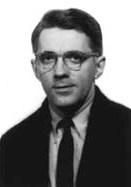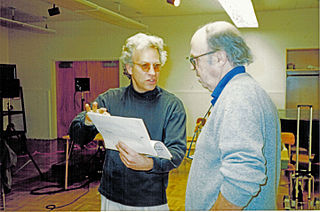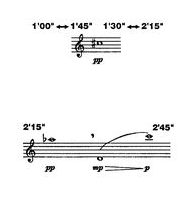Related Research Articles

David Eugene Tudor was an American pianist and composer of experimental music.

John Milton Cage Jr. was an American composer, music theorist, artist, and philosopher. A pioneer of indeterminacy in music, electroacoustic music, and non-standard use of musical instruments, Cage was one of the leading figures of the post-war avant-garde. Critics have lauded him as one of the most influential composers of the 20th century. He was also instrumental in the development of modern dance, mostly through his association with choreographer Merce Cunningham, who was also Cage's romantic partner for most of their lives.

Michael Laurence Nyman, CBE is an English composer of minimalist music, pianist, librettist and musicologist, known for numerous film scores, and his multi-platinum soundtrack album to Jane Campion's The Piano. He has written a number of operas, including The Man Who Mistook His Wife for a Hat; Letters, Riddles and Writs; Noises, Sounds & Sweet Airs; Facing Goya; Man and Boy: Dada; Love Counts; and Sparkie: Cage and Beyond. He has written six concerti, five string quartets, and many other chamber works, many for his Michael Nyman Band. He is also a performing pianist. Nyman prefers to write opera over other forms of music.

Man with a Movie Camera is an experimental 1929 Soviet silent documentary film, directed by Dziga Vertov, filmed by his brother Mikhail Kaufman, and edited by his wife Yelizaveta Svilova. Kaufman also appears as the eponymous Man of the film.
4′33″ is a three-movement composition by American experimental composer John Cage (1912–1992). It was composed in 1952, for any instrument or combination of instruments, and the score instructs performers not to play their instruments during the entire duration of the piece throughout the three movements. The piece consists of the sounds of the environment that the listeners hear while it is performed, although it is commonly perceived as "four minutes thirty-three seconds of silence". The title of the piece refers to the total length in minutes and seconds of a given performance, 4′33″ being the total length of the first public performance.

Earle Brown was an American composer who established his own formal and notational systems. Brown was the creator of "open form," a style of musical construction that has influenced many composers since—notably the downtown New York scene of the 1980s and generations of younger composers.
The Piano Concerto No. 5 in F major, Op. 103, popularly known as The Egyptian, was Camille Saint-Saëns' last piano concerto. He wrote it in 1896, 20 years after his Fourth Piano Concerto, to play himself at his own Jubilee Concert on May 6 of that year. This concert celebrated the fiftieth anniversary of his début at the Salle Pleyel in 1846.

Michael Gordon is an American composer and co-founder of the Bang on a Can music collective and festival. He is based in New York City.

The Helikopter-Streichquartett is one of Karlheinz Stockhausen's best-known pieces, and one of the most complex to perform. It involves a string quartet, four helicopters with pilots, as well as audio and video equipment and technicians. It was first performed and recorded in 1995. Although performable as a self-sufficient piece, it also forms the third scene of the opera Mittwoch aus Licht.
Voices of Light is a 1994 musical composition by Richard Einhorn. It was inspired by the silent film The Passion of Joan of Arc (1928), directed by Carl Theodor Dreyer; live performances of the composition have accompanied screenings of the film. The libretto is based on excerpts from a variety of ancient writings, most of it from medieval female mystics. The text incorporates accusations from Joan of Arc's actual contemporary accusers. The language of this work is a mix of Latin and Middle French.

Henning Lohner is a German-American composer and filmmaker. He is best known for his film scores written as a long-standing member of Hans Zimmer’s music cooperative Remote Control Productions.
Paul Zukofsky was an American violinist and conductor known for his work in the field of contemporary classical music.
American avant-garde composer John Cage (1912–1992) started composing pieces for solo prepared piano around 1938–40. The majority of early works for this instrument were created to accompany dances by Cage's various collaborators, most frequently Merce Cunningham. In response to frequent criticisms of prepared piano, Cage cited numerous predecessors. In the liner notes for the very first recording of his most highly acclaimed work for prepared piano, Sonatas and Interludes, Cage wrote: "Composing for the prepared piano is not a criticism of the instrument. I'm only being practical." This article presents a complete list of Cage's works for prepared piano, with comments on each composition. All of Cage's indeterminate works for unspecified forces can also be performed on or with Prepared Piano.

The term Number Pieces refers to a body of late compositions by John Cage. Each piece is named after the number of performers involved: for instance, Seven is a piece for seven performers, One9 is the ninth work for one performer, and 1O1 is a piece for an orchestra of 101 musicians. The vast majority of these works were composed using Cage's time bracket technique: the score consists of short fragments and indications, in minutes and seconds, during which the fragment can start and by what time it should end. Time brackets can be fixed or flexible.

Brian Peter George St John le Baptiste de la Salle Eno is a British musician, composer, record producer, visual artist, and theorist best known for his pioneering work in ambient music and contributions to rock, pop and electronica. A self-described "non-musician", Eno has helped introduce unique conceptual approaches and recording techniques to contemporary music. He has been described as one of popular music's most influential and innovative figures.

Lohner Carlson is the name of artist duo Henning Lohner and Van Carlson, whose creative collaboration began in 1989. Since Carlson's death in 2011, their act has been continued by Lohner. They are known for their series Active Images, which is regarded as bridging the gap between photography and narrative film, as well as blurring the lines between image and video.
The Revenge of the Dead Indians is a 1993 documentary film essay directed by Henning Lohner about composer John Cage and his theories about music. It pays tribute to Cage's thoughts, music, and influence and has been described as "an unexpected and fascinating combination of intellectual thought, viewpoints and opinions."
Peefeeyatko is a 1991 biographical art film written and directed by Henning Lohner about and in collaboration with acclaimed American composer Frank Zappa. Running 59 minutes, the documentary essay has been called "an intimate music portrait," allowing an insight into the composer's secluded world.
Van Theodore Carlson was an American photographer, cinematographer and visual artist, known for the media art of Lohner Carlson.
References
- 1 2 3 4 "John Cage – Volume 36: One11 with 103". www.moderecords.com. Retrieved 2018-11-15.
- 1 2 ""Neither"". www.art-agenda.com. Retrieved 2018-11-15.
- 1 2 "John Cage's Final Work: ONE11 (1992)". www.the-solute.com. Retrieved 2018-11-15.
- 1 2 3 4 Dickinson, Peter (2013-01-09). "John Cage – One and 103". Gramophone . Retrieved 2018-11-15.
- 1 2 3 4 Silverman, Kenneth (2012). Born Again: A Biography of John Cage. Northwestern University Press. ISBN 9780810128309.
- ↑ Festspiele, Berliner. "Berliner Festspiele – MaerzMusik: 103 for orchestra and film One¹¹ – Konzerthausorchester Berlin". www.berlinerfestspiele.de. Retrieved 2018-11-15.
- 1 2 "Cage: One11; 103 (WDR Symphony Orchestra Köln/Arturo...)". www.classical-music.com. Retrieved 2018-11-15.
- ↑ "Cineinfinito #59: John Cage • CINEINFINITO".
- ↑ "The Sound of Eye: John Cage & Henning Lohner One11 with 103 (1992)". The Sound of Eye. Retrieved 2018-11-15.